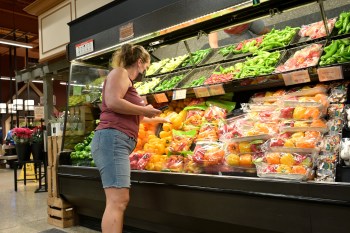
One mom on what the end of additional SNAP benefits means for her family
One mom on what the end of additional SNAP benefits means for her family

There isn’t a whole lot of furniture in Mansie Meikle’s sunny, new apartment in Queens — a plastic folding table, some camping chairs, a couch, a TV. Beds, of course, in the bedrooms. Wall art by her kids. And right by the front door in the kitchen, a little green plastic shelf that’s usually full of snacks for the kids, who are 4, 6 and 9 — individual-sized bags of Doritos and Fritos, apples and bananas.
On a recent Tuesday though, the shelf was almost empty, Meikle’s 4-year-old had informed her before school.
“My daughter this morning, she went to put a snack in her bag, and she was like, ‘Mom. You need to buy more snacks. There’s no snacks over here!’ I’m like, ‘You don’t say!’” she said with a laugh. “And I’m looking, and I’m like, ‘Now I really have to go spend actual money on food.’”
Meikle had been hoping to not have to make another trip to the grocery store quite yet — her February SNAP benefits, or food stamps, have already run out, and it’ll be a few more days before her March benefits arrive. When they do, it’ll also be less money than she’s used to.
As of this month, millions of people are getting less in Supplemental Nutrition Assistance Program, or SNAP benefits. When the pandemic began, the federal government temporarily increased everyone’s SNAP benefits by at least $95 a month and kept those increases in place for the last three years.
Some states ended the extra benefits a few months ago, but 32 — including New York, where Meikle lives — kept them in place. Now though, with the national public health emergency winding down, they’ve ended everywhere.
For Meikle, that means she’ll get about $120 less a month.
Over the last few years, the increase in SNAP benefits “made such a huge difference, especially with the prices of food and everything going up,” she said. “You’re like, ‘Yes! This is so beneficial. This is really good.’ But now you have to really go back to the drawing table, like, how are we going to bridge that gap?”
As a single mom, Meikle is only able to work part-time — about 12 hours a week as a home health aide — because she has no one else to take care of her kids after school, and because she’s also in school herself, working toward her associate’s degree. Right now, she’s only earning about $800 a month; she gets more than that in SNAP benefits.

Even with the increase, her benefits almost never last her the whole month. She tries to plan and buy most of what she thinks they’ll need at the beginning of the month, hoping it’ll last, “and then you realize that the kids that live in your house don’t have, like, endings to their stomachs,” she said.
They’re always asking for something: A snack. A juice pouch. Another snack. More juice.
“Every 15 minutes, I kid you not, if I don’t tell them, ‘no,’ they will literally eat that whole container of snacks in literally one day.”
For the last few years, the increase in SNAP benefits made it possible for her to buy their favorite foods a little more often.
“They get their own milk, you know, the little Nesquik,” she said. “Because money-wise, I can’t afford to buy three different things every time. So when they give me the food stamps, they’d be like, ‘Can we have our own milk?’ And I’m like, ‘Of course! Of course!’”
She rarely has any other way to treat them. Until June, they were living in a homeless shelter. There’s never enough money for the essentials, let alone extras.
“We don’t do anything. Like, I try to make it as fun as I possibly can, but there’s only so much I can do, you know?” Meikle said. “They want cotton candy, they want all the nice stuff, and I’m just like, ‘We can’t. I can’t do that.’ … I get one ice cream that everybody has to share.”
And they understand. She’s direct with them — but still.
So, to be able to buy them chips and juice and strawberry milk, snacks they like and can grab themselves between meals? It’s made a big difference.
Now, with her SNAP benefits being cut and food prices up about 10%, Meikle knows she’s going to have to start saying no again more often. She’s trying not to worry too much about how she’s going to make it all work and make the money stretch longer.
“I will have to spend money, you know — money that I don’t have — on actual food because I can’t let them go without,” she said. “While you might understand that, hey, you know, the funds are not there to get the stuff, kids are more like, ‘Yeah, but we used to have it … and now we don’t.’”
She’d rather be the one to go without if it means her kids have enough.

There’s a lot happening in the world. Through it all, Marketplace is here for you.
You rely on Marketplace to break down the world’s events and tell you how it affects you in a fact-based, approachable way. We rely on your financial support to keep making that possible.
Your donation today powers the independent journalism that you rely on. For just $5/month, you can help sustain Marketplace so we can keep reporting on the things that matter to you.

















